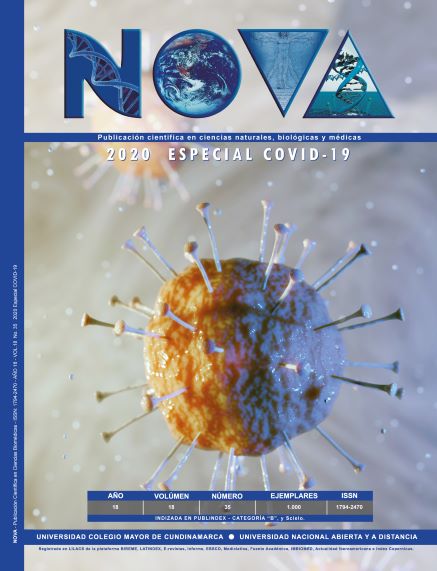Potenciales estrategias terapéuticas basadas en péptidos para mitigar la infección por SARS-CoV-2
Potential Peptide-Based Therapeutic Strategies to Mitigate SARS-COV-2 Infection

NOVA por http://www.unicolmayor.edu.co/publicaciones/index.php/nova se distribuye bajo una Licencia Creative Commons Atribución-NoComercial-SinDerivar 4.0 Internacional.
Así mismo, los autores mantienen sus derechos de propiedad intelectual sobre los artículos.
Mostrar biografía de los autores
La nueva pandemia por SARS-CoV-2 ha incentivado la búsqueda de alternativas terapéuticas que reduzcan los índices de mortalidad. Dentro de estas, el uso de péptidos se destaca por su facilidad de síntesis, fácil producción a gran escala, especificidad en la respuesta inmunológica, versatilidad en la dosificación, alta pureza, economía, entre otros. Esto ofrece una excelente opción al enfoque tradicional, con lo que se resta la evaluación de su eficacia, eficiencia y seguridad a nivel clínico.
Visitas del artículo 217 | Visitas PDF 120
Descargas
1. Huang C, Wang Y, Li X, Ren L, Zhao J, Hu Y, et al. Clinical features of patients infected with 2019 novel coronavirus in Wuhan, China. Lancet. 2020;395(10223):497-506.
2. World Health Organization. Coronavirus disease (COVID-2019) situation reports. Situation report—55. 2020 [ciitado el 17 de junio]. Disponible en: https://www.who.int/docs/default-source/coronaviruse/transcripts/who-audio-emergencies-coronavirus-press-conference-full-and-final-11mar2020.pdf?sfvrsn=cb432bb3_2
3. Vankadari N, Wilce JA. Emerging COVID-19 coronavirus: glycan shield and structure prediction of spike glycoprotein and its interaction with human CD26. Emerg Microbes Infect [Internet]. 2020 Jan 1;9(1):601–4. DOI: 10.1080/22221751.2020.1739565
4. Venkatagopalan P, Daskalova SM, Lopez LA, Dolezal KA, Hogue BG. Coronavirus envelope (E) protein remains at the site of assembly. Virology. 2015;478:75–85.
5. Chan JF-W, Kok K-H, Zhu Z, Chu H, To KK-W, Yuan S, et al. Genomic characterization of the 2019 novel human-pathogenic coronavirus isolated from a patient with atypical pneumonia after visiting Wuhan. Emerg Microbes Infect. 2020;9(1):221–36.
6. Li F, Li W, Farzan M, Harrison SC. Structure of SARS coronavirus spike receptor-binding domain complexed with receptor. Science (80). 2005; 309(5742):1864–8.
7. Hoffmann M, Kleine-Weber H, Schroeder S, Krüger N, Herrler T, Erichsen S, et al. SARS-CoV-2 cell entry depends on ACE2 and TMPRSS2 and is blocked by a clinically proven protease inhibitor. Cell. 2020.
8. Dutta K. A novel peptide analogue of spike glycoprotein shows antiviral properties against SARS-CoV-2. 2020. DOI: 10.21203/rs.3.rs-32796/v1
9. Xia S, Liu M, Wang C, Xu W, Lan Q, Feng S, et al. Inhibition of SARS-CoV-2 (previously 2019-nCoV) infection by a highly potent pan-coronavirus fusion inhibitor targeting its spike protein that harbors a high capacity to mediate membrane fusion. Cell Res. 2020;30(4):343–55.
10. Zhang L, Lin D, Sun X, et al. Crystal structure of SARS-CoV-2 main protease provides a basis for design of improved α-ketoamide inhibitors. Science. 2020;368(6489):409-412. doi:10.1126/science.abb3405
11. Pérez Escoda MT. Diseño y síntesis de péptidos para el diagnóstico de la infección por el virus de la hepatitis G (GBV-C/HGV). Universitat de Barcelona; 2007.
12. Purcell AW, McCluskey J, Rossjohn J. More than one reason to rethink the use of peptides in vaccine design. Nat Rev Drug Discov. 2007;6(5):404–14.
13. Pant S, Singh M, Ravichandiran V, Murty USN, Srivastava HK. Peptide-like and small-molecule inhibitors against Covid-19. J Biomol Struct Dyn. 2020;1–10.
14. Abdelmageed MI, Abdelmoneim AH, Mustafa MI, Elfadol NM, Murshed NS, Shantier SW, et al. Design of a Multiepitope-Based Peptide Vaccine against the E Protein of Human COVID-19: An Immunoinformatics Approach. Biomed Res Int. 2020.
15. World Health Organization. Proyecto de panorama de las vacunas candidatas COVID-19 [Internet]. 2020 [citado el 17 de junio]. Disponible en: https://www.who.int/publications/m/item/draft-landscape-of-covid-19-candidate-vaccines





